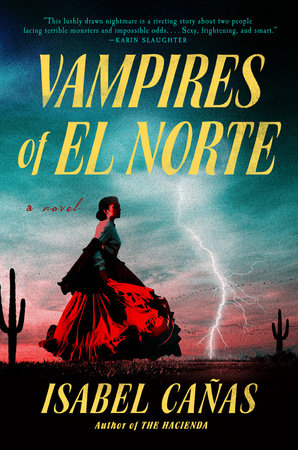Vampires of El Norte by Isabel Cañas is a novel about young love, horror, growing up, invasion, making a place for yourself, finding love again, and fighting several sorts of battles – against uncanny monsters, human monsters, societal expectations, and misunderstandings – in the 1830s and 1840s in a part of northern Mexico that later became part of south Texas.

The word “became” is deceptive, though, because this was not a natural or voluntary evolution. Mexico had allowed and even encouraged immigration from the north after winning its independence from Spain in 1821, and by 1836, the Texians had won their own revolution, although Mexico did not recognize Texas until the end of the Mexican-American War in 1848.
Not that Cañas infodumps much history on the reader; it’s just the deeply researched background. From the perspective of the protagonists, who are 13 when the book opens in 1837, the Anglos are just evil invaders, robbing, killing and displacing the generations of Spanish-speaking settlers of the Rio Grande Valley (the “Indios” whom those inhabitants had displaced themselves receive scant mention).
In the Author’s Note at the end, Cañas quotes an 1859 proclamation by Juan Cortina to Mexican inhabitants of Texas: “Flocks of vampires, in the guise of men, came and scattered themselves in the settlements. Many of you have been robbed of your property, incarcerated, chased, murdered, and hunted like wild beasts, because your labor was fruitful…” She says that finding this helped her find the structure for what had been some nebulous ideas for a book.
So, the book treats the Anglos as a mob of monsters who can hardly be reasoned with, only resisted with counter-violence. But at the beginning, although peon Néstor Duarte’s family had been robbed and displaced, with his father shot dead, and although ranchero’s daughter Nena overhears her elders discussing marriage alliances to strengthen their defenses, the immediate threat is an actual monster they encounter on a late-night treasure-hunting expedition.
While the dreamy teenagers are out in the desert digging for legendary Spanish silver, a shadowy creature attacks Nena and rips at her throat. Néstor manages to dust it with his shovel, but when he carries his bloodied playmate and girlfriend back to the big house of the rancho, they say Nena is dead. Néstor flees her father’s rage and doesn’t come back for nine years.
But Nena isn’t dead. She’d been nursed back to life by Abuela (the Grandmother) and has been learning the skills of a curandera herself, hoping that her skills will let her stay on the rancho instead of being married off to a near-stranger. She performs a limpia (cleansing) to cure a vaquero of the susto, the mysterious sleeping sickness that has been striking young men in the region, and gets her brother to persuade their father to let her accompany their war band as a healer, hoping to prove her value.
Néstor comes back to the rancho as an experienced vaquero to join that war band, and their reunion is rocky. He’s stunned to find her alive, and she’s very angry that he abandoned her for nine years, not realizing he’d thought her dead. But they’re thrown together by the situation, and the story gains momentum from there.
Most of that is mentioned in the book’s promotional materials, so it’s not really spoilery. I’ll just add that although there are more monsters, both human and otherwise, it turns out that some of them can indeed make and keep bargains, when one can find a position of some strength for negotiations – and that strength can come from unexpected places.
I enjoyed reading Vampires of El Norte. The young lovers’ misunderstandings feel natural, not artificially belabored, and the problems they’re dealing with, of trying to negotiate societal and familial expectations and demands to find some degrees of choice, are depicted with understanding, compassion, and warmth. The monsters are scary, the action scenes are exciting, the love story is sweet, and I found the conclusion very satisfying.
The setting of this book was fairly fresh to me, although it’s the history Cañas grew up with. I’ve read a lot of Westerns, but mostly from the Anglo perspective (although some Louis L’Amour novels are quite sympathetic to the plight of Latinos being swindled and crowded out). So it was very interesting to see things from the Mexican perspective. A number of Spanish words were used throughout, but it was always clear to me, from context at least, what was happening.
I wouldn’t exactly call this a Weird West story; it doesn’t have quite that flavor. In many Weird Westerns that I’ve read, most people know that there’s supernatural stuff going on, even if most of them can’t handle it themselves. In this, although there are stories of El Cuco and other monsters, they’re basically viewed as fairy tales for children – until the reality becomes undeniable.
It’s tempting to say that this is predominantly a love story, with all the other plot elements as a backdrop; however, it’s the other elements – monsters, mystery, war, and more – that turn Nestor and Nena into the people they are by the end, who fully understand their choices and learn how to stand up for themselves. Vampires of El Norte blends a lot of genres in an intriguing way, and I look forward to reading more from Isabel Cañas.
Content warnings: Violence, death, war, monsters both human and supernatural, and fade-to-black implied sex.
Comparisons: Wake of Vultures by Lila Bowen; Silver on the Road by Laura Anne Gilman; The Daybreakers by Louis L’Amour.
Disclaimer: Review copy received from the publisher.







